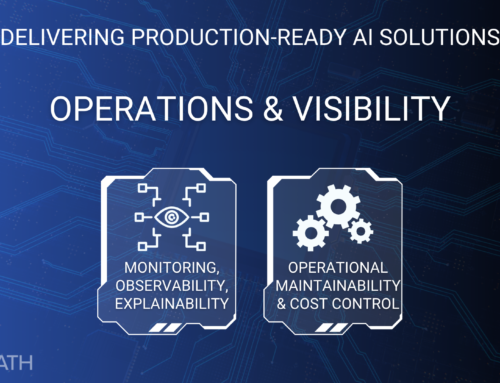Most AI conversations focus on the exciting part: which models to use, what the technology can do, how impressive the results look. But here's what business leaders need to know: your AI project's fate gets decided long before anyone writes a line of code.
The difference between AI systems that transform your business and those that drain your budget comes down to four foundational decisions that most organizations either rush through or skip entirely.
For this reason, CtiPath developed the Production-Ready AI Solutions Framework. The first part of that framework is Foundation & Planning.
The Foundation Trap That Catches Most Organizations
Picture this scenario: Your team demos an AI system that analyzes customer feedback and generates insights in seconds. The presentation goes well. Leadership approves the budget. Six months later, you're sitting in a very different meeting explaining why the system can't handle your actual customer data, why it violates industry regulations you didn't consider, and why the monthly cloud bills are three times what anyone projected.
This isn't a technology failure. t's a foundation failure. The AI worked exactly as designed. But nobody planned for the reality of putting it to work in your business environment.
Think of it like building a house. You can design the most beautiful kitchen in the world, but if you skip the foundation work, you'll be dealing with cracks in the walls, flooding in the basement, and electrical problems that make the whole house uninhabitable.
AI foundations work the same way. Get them right, and everything else becomes manageable. Get them wrong, and even the most sophisticated AI technology becomes a liability.
Foundation Element 1: Business Value That You Can Actually Measure
Most AI business cases sound impressive but fall apart under scrutiny. "Improve customer satisfaction." "Increase operational efficiency." "Enhance decision-making." These aren't business cases; they're hopes.
Real business value measurement means getting specific about problems and solutions. Instead of "improve customer service," try "reduce average response time from 24 hours to 4 hours while maintaining customer satisfaction scores above 4.2 out of 5." Instead of "optimize operations," specify "reduce inventory carrying costs by 15% while maintaining 98% stock availability."
The measurement framework needs to capture three types of costs that most organizations underestimate:
Obvious costs include software licenses, cloud computing, and development time. These show up in initial budgets and procurement discussions.
Hidden costs emerge during implementation: additional development for enterprise integration, ongoing model maintenance, security compliance, and the internal resources required to manage AI systems effectively.
Failure costs represent what happens when AI systems don't meet expectations: wasted development investment, delayed business benefits, and the organizational skepticism that makes future AI initiatives harder to approve.
Organizations that track all three cost categories make better decisions about AI investments and set realistic expectations for returns.
Foundation Element 2: Compliance That Enables Rather Than Constrains
Many organizations treat compliance as a barrier to AI innovation. This backwards thinking creates expensive problems later.
Smart compliance planning treats regulatory requirements as enabling architecture that expands where you can deploy AI rather than limiting what you can do. A healthcare organization that builds HIPAA requirements into their AI architecture from the beginning can pursue patient care applications that competitors can't touch. A financial services firm with proper model risk management can deploy AI in regulated processes where others fear to tread.
The key insight: compliance retrofitting costs roughly three times more than compliance-by-design and often compromises system performance. Trying to add audit trails, data protection, and algorithmic transparency to existing systems is like trying to add a foundation under a house that's already built.
Different industries face different compliance landscapes. Healthcare organizations need HIPAA for patient data, FDA pathways for clinical decisions, and state medical privacy laws. Financial services must consider SOX for financial reporting, banking regulations for algorithmic decisions, and fair lending requirements for credit-related AI.
The complexity multiplies when you operate across jurisdictions. Data that can be processed freely in one country might be restricted in another. AI systems serving global users need architecture that handles these variations without breaking business workflows.
Foundation Element 3: Infrastructure That Grows With Success
Most AI infrastructure planning optimizes for initial deployment rather than business growth. This creates a predictable scaling crisis: the more successful your AI becomes, the more expensive it gets to operate.
Smart infrastructure planning addresses three scaling dimensions that most organizations underestimate:
User scaling means your system works just as well with 1,000 concurrent users as it does with 10. This isn't just about buying bigger servers. It requires architecture patterns that distribute load efficiently and maintain response times under stress.
Data scaling prepares for the reality that successful AI systems attract more data over time. Business adoption grows, historical information accumulates, and data processing requirements can increase exponentially. Storage costs matter, but data transfer and processing costs often surprise organizations.
Geographic scaling becomes necessary when AI systems serve global users or need to comply with data residency requirements. What works perfectly in one cloud region might face performance or compliance challenges when expanded internationally.
The infrastructure decisions you make early determine your scaling costs later. Systems designed for growth handle expansion smoothly. Systems optimized for initial deployment often require expensive re-architecture when success creates demands they can't handle.
Foundation Element 4: Security That Protects What Matters
AI systems create security challenges that don't exist in traditional business applications. They process sensitive information in new ways, make autonomous decisions that affect business operations, and often expose attack surfaces through APIs that handle natural language inputs.
Effective AI security requires thinking beyond traditional IT security to address AI-specific vulnerabilities:
Data protection goes beyond standard encryption to include how AI systems handle sensitive information throughout processing. Unlike traditional applications that process and discard data, AI systems might cache conversation fragments, log inputs for debugging, or inadvertently expose information through model outputs.
Model protection treats your AI models as valuable intellectual property that needs protection from extraction, copying, and reverse-engineering through various attack methods.
Access control needs to understand the difference between users who need AI functionality and those who need access to training data or model management capabilities.
Inference security monitors AI system outputs for signs of compromise including unexpected results, data leakage, and responses that might reveal sensitive training information.
The key principle: security integrated during design costs significantly less and provides more robust protection than security added after deployment. Organizations that treat security as an afterthought often discover vulnerabilities that require expensive system redesigns.
How Foundation Planning Changes Everything
Organizations that invest properly in foundation planning experience fundamentally different AI implementation trajectories than those that rush into development.
Strong foundations enable ambitious use cases. Organizations with proper compliance architecture can pursue AI applications in sensitive areas like healthcare, finance, and legal practice. Those with scalable infrastructure can handle enterprise-wide deployments. Solid security enables AI systems to process confidential information and support business-critical decisions.
Weak foundations limit possibilities regardless of technical capabilities. The most sophisticated AI models can't overcome infrastructure that doesn't scale, security gaps that create liability, or compliance failures that shut down deployments.
Foundation work front-loads effort but reduces total cost. Proper planning takes more time initially but dramatically reduces the expensive rework that characterizes most AI projects. It's cheaper to get foundations right the first time than to fix them while trying to maintain operational systems.
Questions That Reveal Foundation Strength
When evaluating AI initiatives – whether from your own team or external vendors – these questions reveal whether foundations are solid or likely to create problems later:
Business Value: Can you quantify the specific problem this AI solves and measure improvement? Do the success metrics connect directly to business outcomes? Have you planned for the full cost of ownership including hidden and failure costs?
Compliance: Which regulations apply to your AI use case? How will you handle audit requirements and algorithmic transparency? What happens when regulatory requirements change?
Infrastructure: How will system performance change as usage grows? What does geographic expansion look like? How do costs scale with business success?
Security: How does the system protect sensitive information throughout AI processing? What happens if someone tries to extract your AI models? How do you monitor for security issues specific to AI systems?
Detailed, specific answers suggest solid foundation planning. Vague responses or focus purely on AI capabilities indicate foundation gaps that will create problems during implementation.
The Foundation Investment That Pays Dividends
Getting AI foundations right requires more upfront investment than diving straight into model development. But this investment pays dividends throughout the project lifecycle:
Faster development because teams work within clear architectural constraints rather than making foundational decisions during implementation.
Lower integration costs because systems are designed for enterprise environments from the beginning.
Reduced operational overhead because infrastructure, security, and compliance are built for sustainable management.
Competitive advantage through AI capabilities that can be deployed in sensitive environments and use cases that competitors can't address effectively.
Most importantly, strong foundations give business leaders confidence to pursue ambitious AI initiatives because the technical risks are managed systematically rather than discovered during implementation.
The AI transformation is real, but capturing its benefits starts with engineering discipline in foundation planning. Organizations that treat foundation work as essential infrastructure rather than optional overhead position themselves to capture AI's competitive advantages while avoiding the expensive failures that derail less disciplined approaches.
The technology works. The question is whether your foundation planning matches the sophistication of the opportunity.





